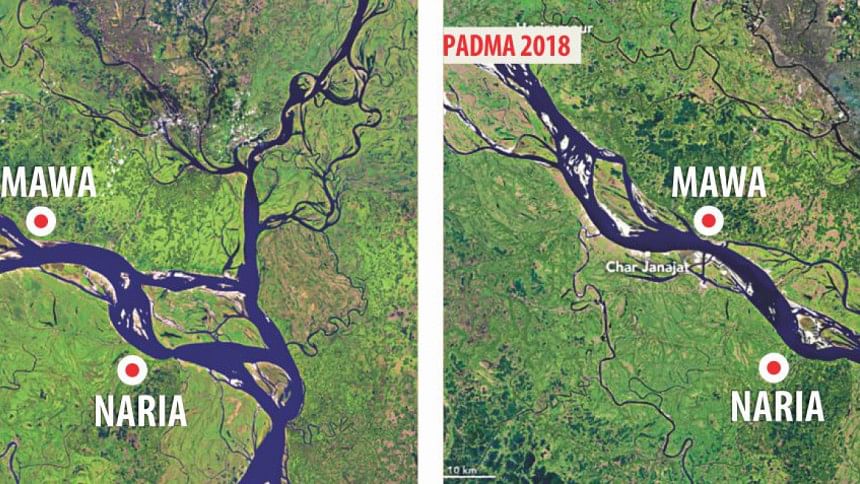Over 66,000 hectares lost to Padma since 1967: NASA report

Over 66,000 hectares (256 square miles) of land have been lost -- roughly the area of Chicago, one of the biggest cities in the US -- to erosion caused by the Padma river since 1967.
That is according to an August 2018 report published by the NASA Earth Observatory, the arm of the US space agency that focuses on the planet we live in.
Numerous farms, houses, and lives have been lost or displaced in recent decades because of riverbank erosion that can swallow large chunks of the shore. Every year, hundreds (sometimes thousands) of hectares of land erode and fall into the river, the report says.
The extreme erosion patterns of the Padma have two main causes. First, it is a natural, free-flowing river with little bank protection, other than some occasional sandbags to protect buildings. Second, the bank sits on a large sand bed that can be eroded quickly.
Scientists measure erosion on the river by noting differences in its width, depth, shape, and overall appearance on satellite images. The NASA report, “Padma River: The Shape of Erosion” compares natural-colour satellite images showing the changes to the shape and width of the river since 1988.
Each “twist and zigzag” is said to tell a different geologic story about the river. The images were acquired by NASA's Landsat satellites. All images were acquired in January and February, during the dry season.
Over the years, researchers have observed an increase in the river's “sinuosity” and “braiding”. Sinuosity is the tendency of the river to snake back and forth in an S-shape across its plain. Rivers with high sinuosity are labeled "meandering”.
Such rivers are said to evolve as the flow wears away the outer edges, widening the channel. The flow on the inner edge has less energy, allowing more sediment to be deposited there. Sometimes meandering rivers leave scars where the water once flowed, as it can be seen in the 2014 image of the Harirampur region in Manikganj.
The sediments can come from a variety of sources. One theory suggests that some of the sediments are remnants from a landslide triggered by an earthquake in 1950. Researchers think the coarser material (like sand) took half a century to pass through the river.
Over the past three decades, the river has changed from a relatively narrow, straight line to meandering to braided and, most recently, back to straight. In the image sequence, the most noticeable change occurs upstream near the Harirampur upazila region, which experienced the most erosion.
A large flood rose over these banks in 1998, exacerbated by the opening of the Farakka Barrage (dam) in India, which released more water into Bangladesh, according to the report.
Further downstream, meandering bends eroded the land near Char Janajat. The river's curves became most extreme from 1995-1996. The curve started to develop in 1992, began to decline in 2002, and has since disappeared.
Researchers are particularly interested in the Char Janajat area, the site of a new bridge crossing. As one of Bangladesh's biggest construction projects, the Padma river bridge will connect the eastern and western parts of the country and shorten travel times between some locations from thirteen hours to three.
“There are some concerns that erosion could threaten the construction of the bridge, although some researchers believe it could actually stabilise the land and reduce erosion once it is finished," the report says.
In recent years, Padma's erosion rates, sinuosity, and braiding have actually decreased. Erosion is said to have slowed as the meandering bends disappeared due to sedimentation.
“But that does not mean the area is free from erosion. Any disturbance in the ecosystem, such as floods, landslides, or construction, could influence the morphology of the river,” the report mentions.

 For all latest news, follow The Daily Star's Google News channel.
For all latest news, follow The Daily Star's Google News channel. 




Comments